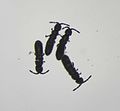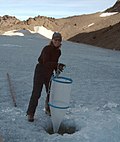Snow algae are a group of freshwater micro-algae that grow in the alpine and polar regions of the Earth. Snow algae have been found on every continent...
12 KB (1,396 words) - 14:50, 28 July 2024
Watermelon snow, also called snow algae, pink snow, red snow, or blood snow, is a phenomenon caused by Chlamydomonas nivalis, a species of green algae containing...
10 KB (1,298 words) - 11:25, 9 May 2024
organisms are bacteria or archaea, but some eukaryotes such as lichens, snow algae, phytoplankton, fungi, and wingless midges, are also classified as psychrophiles...
29 KB (3,216 words) - 16:26, 24 January 2024
Algae are a type of Protist. Algae may also refer to: Algae fuel, a biofuel Algae eaters, species that feed on algae Snow algae, cold-tolerant species...
441 bytes (89 words) - 22:35, 23 June 2020
algae consisting of about 150 species of unicellular flagellates, found in stagnant water and on damp soil, in freshwater, seawater, and even in snow...
10 KB (1,060 words) - 12:03, 20 July 2024
Ice algae are any of the various types of algal communities found in annual and multi-year sea, and terrestrial lake ice or glacier ice. On sea ice in...
40 KB (4,817 words) - 09:26, 11 August 2024
Algae (UK: /ˈælɡiː/ AL-ghee, US: /ˈældʒiː/ AL-jee; sg.: alga /ˈælɡə/ AL-gə) are any of a large and diverse group of photosynthetic, eukaryotic organisms...
91 KB (10,500 words) - 01:17, 28 August 2024
Chlamydomonas nivalis (category Snow algae)
one of the main algae responsible for causing the phenomenon of watermelon snow (also blood snow, raspberry snow), where patches of snow appear red or pink...
29 KB (3,893 words) - 05:02, 27 April 2024
(Mesenchytraeus solifugus) and the Yosemite snow worm (Mesenchytraeus gelidus). Ice worms eat snow algae and bacteria. They live at zero degrees Celsius...
13 KB (1,344 words) - 10:18, 9 May 2024
Victoria Tennant Red snow, a type of snow algae Watermelon snow, reddish snow caused by above type of snow algae 30 Days of Night: Red Snow, a prequel to the...
1,013 bytes (162 words) - 21:48, 1 December 2021
feeds on substances such as cryoconite, pollen and plant remains and snow algae of the genus Chlamydomonas. The jet black animal is easy to spot on light...
4 KB (227 words) - 18:20, 3 May 2023
conditions with corn snow. Watermelon snow – Watermelon snow is reddish pink, caused by a red-colored green algae called Chlamydomonas nivalis. Not surprisingly...
37 KB (3,976 words) - 22:01, 15 July 2024
the ocean many algae are found in freshwater both on the continent and on the subantarctic islands. Terrestrial algae, such as snow algae, have been found...
66 KB (6,843 words) - 00:23, 6 August 2024
bluegrass). Of the 700 species of algae in Antarctica, around half are marine phytoplankton. Multicoloured snow algae are especially abundant in the coastal...
143 KB (15,461 words) - 02:53, 28 August 2024
Llullaillaco (section Snow and glaciers)
Lichens grow on rocks. Algae including snow algae and cyanobacteria live on the penitentes, sometimes forming coloured patches, and algae and microbial mats...
104 KB (11,672 words) - 12:09, 16 August 2024
Not much is known about the ice worm's diet, but it is thought to eat snow algae, as well as some bacteria. Ice worms inhabit glaciers and can be found...
15 KB (1,682 words) - 05:20, 10 December 2023
limited because of the ice cover, although snow algae are recorded. The remaining vegetation is located in snow-free areas such as nunatak ridges and other...
62 KB (5,398 words) - 06:38, 1 August 2024
endolith or endolithic is an organism (archaeon, bacterium, fungus, lichen, algae or amoeba) that is able to acquire the necessary resources for growth in...
31 KB (3,415 words) - 01:42, 30 June 2024
Chloromonas (category Snow algae)
of species are adapted to living on snow, making them snow algae. The most northerly location at which this algae has been observed is Lake Bienville...
6 KB (551 words) - 03:51, 28 December 2023
ISSN 2045-2322. PMC 6934841. PMID 31882659. Takeuchi, Nozomu (2014). "Snow algae on Alaskan glaciers". Archived from the original on 29 March 2018. Retrieved...
53 KB (6,322 words) - 21:30, 18 July 2024
Nedbalová is a Czech Antarctic researcher, best known for her work on snow algae. Nedbalová was born in 1976 in Prague (Czech Republic). She received her...
8 KB (644 words) - 23:43, 30 August 2023
dominated by lichens, followed by mosses and ice algae. In the Antarctic Peninsula alone, green snow algae have a combined biomass of ~1300 tonnes. As glaciers...
97 KB (10,940 words) - 10:41, 29 August 2024
Dinoflagellate (redirect from Dinoflagellate algæ)
Dinoflagellida. Botanists treated them as a division of algae, named Pyrrophyta or Pyrrhophyta ("fire algae"; Greek pyrr(h)os, fire) after the bioluminescent...
96 KB (10,335 words) - 22:55, 26 August 2024
meters (820 to 1,033 ft) and above lifeless snow desert, with occasional lichens on nunataks and snow algae on glacier surfaces. Trees, shrubs and tall...
48 KB (5,772 words) - 07:33, 23 August 2024
Snow comprises individual ice crystals that grow while suspended in the atmosphere—usually within clouds—and then fall, accumulating on the ground where...
102 KB (10,538 words) - 22:23, 4 August 2024
Algal bloom (redirect from Algae bloom)
An algal bloom or algae bloom is a rapid increase or accumulation in the population of algae in freshwater or marine water systems. It is often recognized...
29 KB (3,364 words) - 05:08, 27 August 2024
it is the type locality for several species of algae, including the southernmost record of snow algae. Map all coordinates using OpenStreetMap Download...
12 KB (1,875 words) - 13:08, 29 March 2024
glaciers take on a red tint; this is the result of a variety of snow algae known as watermelon snow. All watercourses in the park are part of the Columbia River...
42 KB (4,188 words) - 00:52, 6 June 2024
to be a large component of sources for algae loss from surface water. Most organic components of marine snow are consumed by microbes, zooplankton and...
22 KB (2,737 words) - 21:03, 24 June 2024
Chlainomonas (category Snow algae)
a genus of algae in the family Chlamydomonadaceae. They are found in freshwater habitats or on snow, where they are one of the main algae responsible...
5 KB (574 words) - 01:31, 25 December 2023


























